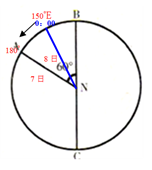图中N为北极点,A、B为晨昏线与纬线的交点,C为该纬线上一点。读图完成问题。

小题1:该日C地的日出时间和可能的月份为
A.2时 5月
B.10时 6月
C.2时 11月
D.8时 12月小题2:若A、B所夹劣弧为夜弧,且A点两侧日期不同,为7日和8日,则此时北京时间为
A. 7日18时 B. 7日22时
C. 8日18时 D. 8日22时
小题1:A
小题2:D
题目分析:
小题1:N为北极点,A、B为晨昏线与纬线的交点,则AB弧要么是昼弧,要么是夜弧,若AB弧是昼弧,则该日昼长为60o/15o/h=4h,即C地昼长为4小时,10:00日出,则北极点附近为极夜现象,对应下半年时间,可能为11或12月;若AB弧是夜弧,则该日夜长为60o/15o/h=4h,即C地夜长为4小时,2:00日出,则北极点附近为极昼现象,对应上半年时间,可能为5或6月;综合分析本题选A。
小题2:若A、B所夹劣弧为夜弧,则平分AB弧的经线地方时为0:00,如下图所示。又因为A点两侧日期不同,为7日和8日,则A点所在经线为180度经线,根据自西向东过180度经线减一天,确定7日、8日范围,由图可知150oE地方时为0:00,则此时北京时间即120oE的地方时为7日22时。

点评:本题难度较大,解答本题的关键是:(1)明确同一条纬线圈上的点日出日落时刻相同,昼夜长短相同,正午太阳高度相同。(2)明确日期分界线的判断方法,自西向东过180度经线减一天,自西向东过0时经线加一天。(3)明确北京时间就是120oE的地方时,东八区的区时。
